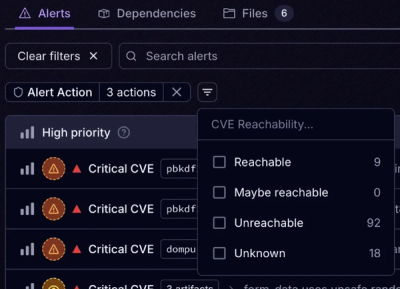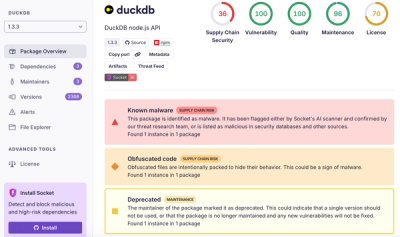
Product
Introducing Tier 1 Reachability: Precision CVE Triage for Enterprise Teams
Socket’s new Tier 1 Reachability filters out up to 80% of irrelevant CVEs, so security teams can focus on the vulnerabilities that matter.
react-native-device-activity
Advanced tools
React Native wrapper for Apple's Screen Time, Device Activity, and Family Controls APIs.
⚠️ Important: These APIs require special approval and entitlements from Apple. Request this approval as early as possible in your development process.
(See WWDC21 for official details.)
Note: Depending on your use case, you might not need all the APIs hence not all the new bundle identifier and capabilities are required. Below is a quick overview of the APIs available.
The FamilyControl API allows your app to access Screen Time data and manage restrictions on apps and websites.
What it does: Provides access to selection and monitoring of app/website usage Example: Selecting which apps (e.g., Instagram, TikTok) to monitor or block
Defines the visual appearance and text shown when users attempt to access blocked content.
What it does: Customizes the blocking screen UI Example:
const shieldConfig = {
title: "Time for a Break!",
subtitle: "These apps are unavailable until midnight.",
primaryButtonLabel: "OK",
iconSystemName: "moon.stars.fill",
};
Defines what happens when users interact with shield buttons.
What it does: Controls behavior when users tap buttons on the shield Example:
const shieldActions = {
primary: {
behavior: "close", // Just close the shield when OK is tapped
},
};
Schedules and manages when restrictions should be applied or removed. This is what will activate the shield when your app is killed.
What it does: Monitors device activity against schedules and thresholds Example:
// Block social media from 7PM to midnight daily
ReactNativeDeviceActivity.startMonitoring(
"evening_block",
{
intervalStart: { hour: 19, minute: 0 },
intervalEnd: { hour: 23, minute: 59 },
repeats: true,
},
[],
);
Install the package:
npm install react-native-device-activity
# or
yarn add react-native-device-activity
Configure the Expo plugin in your app.json or app.config.js:
"plugins": [
[
"expo-build-properties",
{
"ios": {
"deploymentTarget": "15.1"
},
},
],
[
"react-native-device-activity",
{
"appleTeamId": "<YOUR_TEAM_ID>",
"appGroup": "group.<YOUR_APP_GROUP_NAME>"
}
]
],
Generate the native projects:
npx expo prebuild --platform ios
Verify Xcode Targets: After running prebuild, open the ios directory in Xcode (open ios/YourProject.xcworkspace). Check that you have the following targets in addition to your main app target:
ActivityMonitorExtensionShieldActionShieldConfigurationAlmost all the functionality is built around persisting configuration as well as event history to UserDefaults.
For bare React Native projects, you must ensure that you have installed and configured the expo package before continuing.
npm install react-native-device-activity
Run npx pod-install after installing the npm package.
As early as possible you want to request approval from Apple, since it can take time to get approved.
Note that until you have approval for all bundleIdentifiers you want to use, you are stuck with local development builds in XCode. i.e., you can't even build an Expo Dev Client.
For every base bundleIdentifier you need approval for 4 bundleIdentifiers (when leveraging all native extensions that is, you can potentially just use the Shield-related ones if you have no need to listen to the events, or similarly just use the ActivityMonitor if you do not need control over the Shield UI):
com.your-bundleIdentifiercom.your-bundleIdentifier.ActivityMonitorcom.your-bundleIdentifier.ShieldActioncom.your-bundleIdentifier.ShieldConfigurationOnce you've gotten approval you need to manually add the "Family Controls (Distribution)" under Additional Capabilities for each of the bundleIdentifiers on developer.apple.com mentioned above. If you use Expo/EAS this has to be done only once, and after that provisioning will be handled automatically.
⚠️ If you don't do all the above, you will run into a lot of strange provisioning errors.
Here's another example that focuses on tracking app usage with time thresholds:
import * as ReactNativeDeviceActivity from "react-native-device-activity";
ReactNativeDeviceActivity.revokeAuthorization();
For most use cases you need to get an activitySelection from the user, which is a token representing the apps the user wants to track, block or whitelist. This can be done by presenting the native view:
import * as ReactNativeDeviceActivity from "react-native-device-activity";
const DeviceActivityPicker = () => {
// First things first, you need to request authorization
useEffect(() => {
ReactNativeDeviceActivity.requestAuthorization()
}, [])
const [familyActivitySelection, setFamilyActivitySelection] = React.useState(null);
// next you need to present a native view to let the user select which activities to track, you need to do this before you can start tracking (this is a completely unstyled clickable native view):
return (
<ReactNativeDeviceActivity.DeviceActivitySelectionView
onSelectionChange={(event) => {
setFamilyActivitySelection(
event.nativeEvent.familyActivitySelection
)
}}
familyActivitySelection={familyActivitySelection} />
)
}
}
Some things worth noting here:
It's worth noting that the Screen Time API is not designed for time tracking out-of-the-box. So you have to set up events with names you can parse as time after they've triggered.
import * as ReactNativeDeviceActivity from "react-native-device-activity";
// once you have authorization and got hold of the familyActivitySelection (which is a base64 string) you can start tracking with it:
const trackDeviceActivity = (activitySelection: string) => {
ReactNativeDeviceActivity.startMonitoring(
"TimeTrackingActivity",
{
// repeat logging every 24 hours
intervalStart: { hour: 0, minute: 0, second: 0 },
intervalEnd: { hour: 23, minute: 59, second: 59 },
repeats: true,
},
events: [
{
eventName: 'minutes_reached_10', // remember to give event names that make it possible for you to extract time at a later stage, if you want to access this information
familyActivitySelection: activitySelection,
threshold: { minute: 10 },
}
]
);
}
// you can listen to events (which only works when the app is alive):
const listener = ReactNativeDeviceActivity.onDeviceActivityMonitorEvent(
(event) => {
const name = event.nativeEvent.callbackName; // the name of the event
/* callbackName is one of, corresponding to the events received from the native API:
- "intervalDidStart"
- "intervalDidEnd"
- "eventDidReachThreshold"
- "intervalWillStartWarning"
- "intervalWillEndWarning"
- "eventWillReachThresholdWarning";
*/
}
);
// you can also get a history of events called with the time where called:
const events = ReactNativeDeviceActivityModule.getEvents();
Some things worth noting here:
Depending on your use case (if you need different schedules for different days, for example) you might need multiple monitors. There's a hard limit on 20 monitors at the same time. Study the DateComponents object to model this to your use case.
To block apps, you can do it directly from your code.
import * as ReactNativeDeviceActivity from "react-native-device-activity";
// block all apps
ReactNativeDeviceActivity.blockSelection({
activitySelectionId: selectionId,
});
But for many use cases you want to do this in the Swift process, which is why you can specify actions when setting up events:
const trackDeviceActivity = (activitySelection: string) => {
ReactNativeDeviceActivity.startMonitoring(
"BlockAfter10Minutes",
{
// repeat logging every 24 hours
intervalStart: { hour: 0, minute: 0, second: 0 },
intervalEnd: { hour: 23, minute: 59, second: 59 },
repeats: true,
},
events: [
{
eventName: 'minutes_reached_10', // remember to give event names that make it possible for you to extract time at a later stage, if you want to access this information
familyActivitySelection: activitySelection,
threshold: { minute: 10 },
actions: [
{
type: "blockSelection",
familyActivitySelectionId,
}
]
}
]
);
}
There are many other actions you can perform, like sending web requests or notifications. The easiest way to explore this is by using TypeScript, which is easier to keep up-to-date than this documentation.
You can also configure the shield UI and actions of the shield (this can also be done in the Swift process with actions):
ReactNativeDeviceActivity.updateShield(
{
title: shieldTitle,
backgroundBlurStyle: UIBlurEffectStyle.systemMaterialDark,
// backgroundColor: null,
titleColor: {
red: 255,
green: 0,
blue: 0,
},
subtitle: "subtitle",
subtitleColor: {
red: Math.random() * 255,
green: Math.random() * 255,
blue: Math.random() * 255,
},
primaryButtonBackgroundColor: {
red: Math.random() * 255,
green: Math.random() * 255,
blue: Math.random() * 255,
},
primaryButtonLabelColor: {
red: Math.random() * 255,
green: Math.random() * 255,
blue: Math.random() * 255,
},
secondaryButtonLabelColor: {
red: Math.random() * 255,
green: Math.random() * 255,
blue: Math.random() * 255,
},
},
{
primary: {
type: "disableBlockAllMode",
behavior: "defer",
},
secondary: {
type: "dismiss",
behavior: "close",
},
},
)
This example shows how to implement a complete app blocking system on a given interval. The main principle is that you're configuring these apps to be blocked with FamilyControl API and then schedule when the shield should be shown with ActivityMonitor API. You're customizing the shield UI and actions with ShieldConfiguration and ShieldAction APIs.
import { useEffect, useState } from 'react';
import { Alert, View, Button } from 'react-native';
import * as ReactNativeDeviceActivity from 'react-native-device-activity';
// Constants for identifying your selections, shields and scheduled activities
const SELECTION_ID = "evening_block_selection";
const SHIELD_CONFIG_ID = "evening_shield_config";
const ACTIVITY_NAME = "evening_block";
const AppBlocker = () => {
// Step 1: Request authorization when component mounts
useEffect(() => {
ReactNativeDeviceActivity.requestAuthorization().then((status) => {
console.info("Authorization status:", status);
// You need to handle various status outcomes:
// "authorized", "denied", "notDetermined", etc.
});
}, []);
// Step 2: Manage the selection state of apps/websites to block
const [currentFamilyActivitySelection, setCurrentFamilyActivitySelection] =
useState<string | null>(null);
// Step 3: Handle selection changes from the native selection UI
const handleSelectionChange = (event) => {
// The selection is a serialized string containing the user's app selections
setCurrentFamilyActivitySelection(event.nativeEvent.familyActivitySelection);
};
// Step 4: Save the selection for use by the extension
const saveSelection = () => {
if (!currentFamilyActivitySelection) {
Alert.alert("Error", "Please select at least one app to block");
return;
}
// Store the selection with a consistent ID so the extension can access it
ReactNativeDeviceActivity.setFamilyActivitySelectionId({
id: SELECTION_ID,
familyActivitySelection: currentFamilyActivitySelection
});
// Now configure the blocking schedule
configureBlocking();
};
// Step 5: Configure the shield (blocking screen UI)
const configureBlocking = () => {
// Define how the blocking screen looks
const shieldConfig = {
title: "App Blocked",
subtitle: "This app is currently unavailable",
primaryButtonLabel: "OK",
iconSystemName: "moon.stars.fill" // SF Symbols icon name
};
// Define what happens when users interact with the shield
const shieldActions = {
primary: {
behavior: "close" // Just close the shield when OK is tapped
}
};
// Apply the shield configuration
ReactNativeDeviceActivity.updateShield(shieldConfig, shieldActions);
// Configure what happens when the scheduled interval begins
ReactNativeDeviceActivity.configureActions({
activityName: ACTIVITY_NAME,
callbackName: "intervalDidStart", // Called when the scheduled time begins
actions: [{
type: "blockSelection",
familyActivitySelectionId: SELECTION_ID, // The stored selection ID
shieldId: SHIELD_CONFIG_ID // The shield to show when blocked
}]
});
// Configure what happens when the scheduled interval ends
ReactNativeDeviceActivity.configureActions({
activityName: ACTIVITY_NAME,
callbackName: "intervalDidEnd", // Called when the scheduled time ends
actions: [{
type: "unblockSelection",
familyActivitySelectionId: SELECTION_ID // Unblock the same selection
}]
});
// Start the monitoring schedule
startScheduledBlocking();
};
// Step 6: Define and start the blocking schedule
const startScheduledBlocking = async () => {
try {
// Define when blocking should occur (7 PM to midnight daily)
const schedule = {
intervalStart: { hour: 19, minute: 0 }, // 7:00 PM
intervalEnd: { hour: 23, minute: 59 }, // 11:59 PM
repeats: true // Repeat this schedule daily
// Optional: warningTime: { minutes: 5 } // Warn user 5 minutes before blocking starts
};
// For testing, you might want a shorter interval that starts soon:
const testSchedule = {
intervalStart: {
hour: new Date().getHours(),
minute: new Date().getMinutes(),
second: (new Date().getSeconds() + 10) % 60, // +10 seconds from now
},
intervalEnd: {
hour: new Date().getHours() + Math.floor((new Date().getMinutes() + 5) / 60),
minute: (new Date().getMinutes() + 5) % 60, // +5 minutes from start
},
repeats: false, // One-time test
};
// Start monitoring with the schedule
// The empty array is for event monitors (optional)
await ReactNativeDeviceActivity.startMonitoring(
ACTIVITY_NAME,
schedule, // Use testSchedule for testing
[]
);
Alert.alert("Success", "Blocking schedule has been set up!");
} catch (error) {
console.error("Failed to start scheduled blocking:", error);
Alert.alert("Error", "Failed to set up blocking schedule");
}
};
return (
<View style={{ flex: 1 }}>
{/* Native selection view for choosing apps to block */}
<ReactNativeDeviceActivity.DeviceActivitySelectionView
onSelectionChange={handleSelectionChange}
familyActivitySelection={currentFamilyActivitySelection}
style={{
width: "100%",
flex: 1
}}
/>
{/* Save button */}
<Button
title="Save Selection and Schedule Blocking"
onPress={saveSelection}
/>
</View>
);
};
DeviceActivitySelectionView.For a complete implementation, see the example app.
| Component | Props | Description |
|---|---|---|
DeviceActivitySelectionView | familyActivitySelection: string | nullonSelectionChange: (event) => voidstyle: ViewStyle | Native component that renders the app selection UI |
| Hook | Returns | Description |
|---|---|---|
useDeviceActivityPicker | currentFamilyActivitySelection: string | nullisActivityPickerLoading: booleanonSave: () => voidonCancel: () => voidhandleSelectionChange: (event) => void | Hook for managing the selection of apps to block |
| Function | Parameters | Returns | Description |
|---|---|---|---|
requestAuthorization | None | Promise<string> | Request Screen Time authorization |
startMonitoring | activityName: stringschedule: DeviceActivityScheduleevents: DeviceActivityEvent[] | Promise<void> | Start monitoring with given schedule |
stopMonitoring | activityName: string | Promise<void> | Stop monitoring for given activity |
setFamilyActivitySelectionId | { id: string, familyActivitySelection: string } | void | Store a family activity selection with given ID |
updateShield | config: ShieldConfigurationactions: ShieldActions | void | Update the shield UI and actions |
configureActions | { activityName: string, callbackName: string, actions: Action[] } | void | Configure actions for monitor events |
getEvents | None | DeviceActivityEvent[] | Get history of triggered events |
userDefaultsSet | key: stringvalue: any | void | Store value in shared UserDefaults |
userDefaultsGet | key: string | any | Retrieve value from shared UserDefaults |
Contributions are very welcome! Please refer to guidelines described in the contributing guide.
Authorization changes outside app not captured When we've asked whether the user has authorized us to use screen time, and the state is changed outside the app, the native API doesn't update until the app restarts, i.e. this flow:
We can both request and revoke permissions as we like, and how many times we like, even when the user has denied permissions. This is very unlike most authorization flows on iOS.
When calling getAuthorizationStatus it can sometimes return notDetermined even though the user has already made a choice, this comes with a delay. Workaround: keep polling the status for a while (pollAuthorizationStatus is a convenience function for this).
The DeviceActivitySelectionView is prone to crashes, which is outside of our control. The best we can do is provide fallback views that allows the user to know what's happening and reload the view.
The Screen Time APIs are known to be very finnicky. Here are some things you can try to troubleshoot events not being reported:
FAQs
Provides access to Apples DeviceActivity API
We found that react-native-device-activity demonstrated a healthy version release cadence and project activity because the last version was released less than a year ago. It has 1 open source maintainer collaborating on the project.
Did you know?

Socket for GitHub automatically highlights issues in each pull request and monitors the health of all your open source dependencies. Discover the contents of your packages and block harmful activity before you install or update your dependencies.

Product
Socket’s new Tier 1 Reachability filters out up to 80% of irrelevant CVEs, so security teams can focus on the vulnerabilities that matter.

Research
/Security News
Ongoing npm supply chain attack spreads to DuckDB: multiple packages compromised with the same wallet-drainer malware.

Security News
The MCP Steering Committee has launched the official MCP Registry in preview, a central hub for discovering and publishing MCP servers.